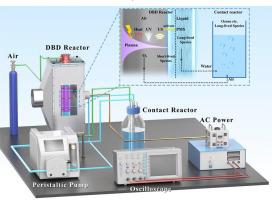Chemical Engineering Journal ( IF 13.3 ) Pub Date : 2023-03-20 , DOI: 10.1016/j.cej.2023.142491 Ruoyu Deng , Dongxu Yang , Mengli Chen , Qiang He , Qingjuan He , Yi Chen

|
Nonthermal plasma has attracted extensive attention because of its ability to remove emerging organic micropollutants. However, its high amount of energy consumption severely limits its economic feasibility. In this study, sulfadiazine degradation was achieved in an optimized dielectric barrier discharge (DBD)-Contact system. The sulfadiazine removal in the DBD-Contact/peroxymonosulfate (PMS) system reached 91.8% within 15 min. Compared to a conventional DBD system, the energy efficiency (G50) of the DBD-Contact/PMS system was 4.37 times greater, which meant a saving of 77.17% in electricity consumption. The reactive species generated by discharge plasma were identified as mostly excited nitrogen species in the gas phase, and after transferred to the water phase,  OH and SO4
OH and SO4 − played an important role in the sulfadiazine removal. The hydroxylation of the S-N bond and the nucleophilic reaction of the pyrimidine ring were proposed as mechanisms for the sulfadiazine degradation, and the developmental and acute toxicity was significantly reduced after treatment. Furthermore, the DBD-Contact/PMS system showed good applicability in a wide pH range and complex practical water samples. This study finds that the DBD-Contact/PMS system can degrade antibiotics with high efficiency and low energy consumption and provides new insights for the practical application of DBD technology in water treatment.
− played an important role in the sulfadiazine removal. The hydroxylation of the S-N bond and the nucleophilic reaction of the pyrimidine ring were proposed as mechanisms for the sulfadiazine degradation, and the developmental and acute toxicity was significantly reduced after treatment. Furthermore, the DBD-Contact/PMS system showed good applicability in a wide pH range and complex practical water samples. This study finds that the DBD-Contact/PMS system can degrade antibiotics with high efficiency and low energy consumption and provides new insights for the practical application of DBD technology in water treatment.
中文翻译:

使用 DBD 接触等离子体处理工艺提高磺胺嘧啶降解的能量效率
非热等离子体因其去除新出现的有机微污染物的能力而受到广泛关注。然而,其高能耗严重限制了其经济可行性。在这项研究中,磺胺嘧啶降解是在优化的介质阻挡放电 (DBD) 接触系统中实现的。DBD-Contact/peroxymonosulfate (PMS) 系统中的磺胺嘧啶去除率在 15 分钟内达到 91.8%。与传统的DBD系统相比,DBD-Contact/PMS系统的能源效率(G 50 )提高了4.37倍,这意味着节省了77.17%的电力消耗。放电等离子体产生的活性物质经鉴定主要是气相中的激发态氮物质,转移到水相后, OH和SO 4
OH和SO 4 −在去除磺胺嘧啶方面发挥了重要作用。SN 键的羟基化和嘧啶环的亲核反应被认为是磺胺嘧啶降解的机制,处理后发育和急性毒性显着降低。此外,DBD-Contact/PMS 系统在广泛的 pH 范围和复杂的实际水样中表现出良好的适用性。本研究发现DBD-Contact/PMS系统能够高效、低能耗地降解抗生素,为DBD技术在水处理中的实际应用提供了新的思路。
−在去除磺胺嘧啶方面发挥了重要作用。SN 键的羟基化和嘧啶环的亲核反应被认为是磺胺嘧啶降解的机制,处理后发育和急性毒性显着降低。此外,DBD-Contact/PMS 系统在广泛的 pH 范围和复杂的实际水样中表现出良好的适用性。本研究发现DBD-Contact/PMS系统能够高效、低能耗地降解抗生素,为DBD技术在水处理中的实际应用提供了新的思路。













































 京公网安备 11010802027423号
京公网安备 11010802027423号